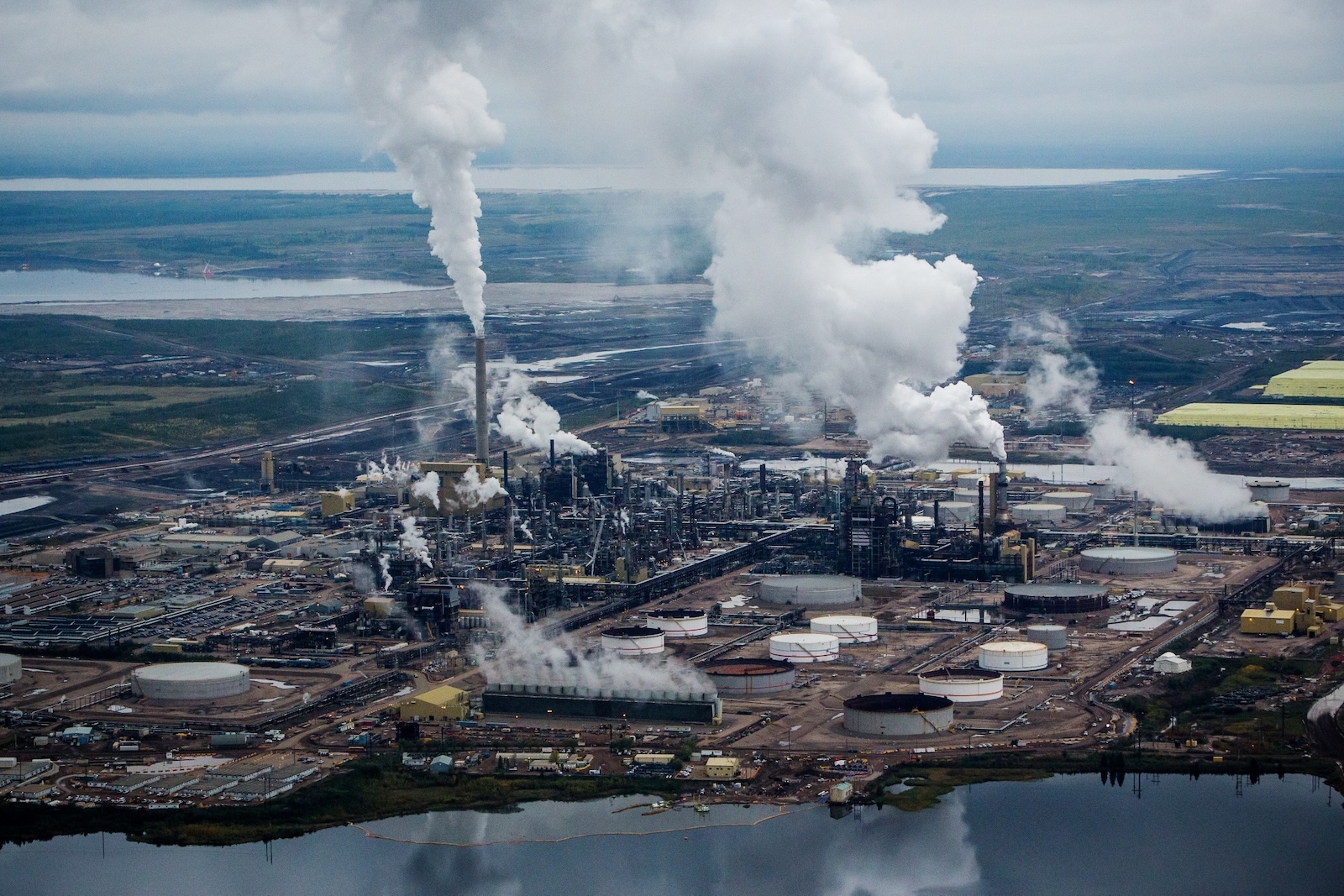In 2019, under Justin Trudeau’s leadership, the Liberal Party of Canada introduced a federally mandated Carbon Tax, starting at $20 per tonne of CO2-equivalent greenhouse gas emissions. By 2023, the price had risen to $65 per tonne, with plans to increase it by $15 annually until it stabilizes at $170 per tonne in 2030. The government aims to keep the tax revenue neutral by returning the majority of the revenue to Canadians through rebates. This, they claim, is the best plan for reducing carbon emissions.
However, a significant flaw undermines this plan. The oil and gas industry is largely exempt from the carbon tax, raising an important question: why is the burden of taxation placed on consumers when the oil and gas sector is the largest producer of carbon emissions in Canada? In 2022, the oil and gas industry was responsible for 31% of total GHG emissions in Canada, a figure that has steadily increased every year since 1990.
The Liberal Party claims to have the most effective and least costly climate policy among the four main federal political parties. But if success is measured by lower emissions, the results suggest their policy isn’t working. Despite the rising carbon tax, emissions have not decreased significantly, and are in fact steadily increasing.
We saw a quick decline in emissions in 2020 during the pandemic, but emissions have been rising since life began returning to normal. In 2020, emissions levels were at 678 megatonnes. By 2022, emissions rose to 708 megatonnes, representing a 4.4 percent increase over two years.
While emissions are still below 2019 levels, it’s challenging to determine if the Carbon Tax is driving reductions or if other factors are at play, such as the increased number of people working from home. Recent studies suggest that working remotely can cut your carbon footprint in half.
In April 2020, about 40 percent of Canada’s workforce was working from home, a significant jump from just 4 percent in 2016. By November 2023, only 20 percent of workers were still working remotely. As more people return to commuting, emissions seem to be correspondingly rising.
If the benchmark for a successful climate policy is the reduction of greenhouse gas emissions, then the current carbon tax appears to fall short. Despite the government patting itself on the back for their climate policies, emissions continue to climb.
And while British Columbia has touted its own climate plan as among the best in the world, climate experts and environmental advocates point out that the province’s emissions keep climbing — in part due to ongoing investment in fossil fuels.
- Michelle Ghoussoub, CBC News
British Columbia’s revenue-neutral carbon tax, one of the first implemented in North America, came into effect in 2008. Despite this early adoption, emissions either remained relatively steady or increased until 2020, when the pandemic caused a temporary drop. However, emissions were still about one percent higher than the levels reported from 2009-2012. Even with the introduction of the carbon tax, British Columbia’s annual emissions still increased by 2.5 percent from 2005 to 2022, rising from 62.7 megatonnes (Mt) to 64.3 Mt.
In contrast, Ontario experienced a significant reduction in emissions during the same period. From 2005 to 2022, Ontario’s emissions dropped by nearly 23 percent, decreasing from 203 Mt to 157 Mt. This substantial decline was primarily due to investments in switching from coal power plants to less carbon-intensive alternatives.
The conclusion from this data is clear: revenue-neutral carbon taxes alone do very little to combat climate change, whereas direct investment in tangible solutions has a pronounced effect on reducing emissions.
The Revenue Potential of the Carbon Tax
It is surprisingly difficult to find public data on how much revenue the government is generating from the carbon tax. A Google search for “Canada federal carbon tax revenue 2023” yields few useful results. You have to dig deep to uncover any meaningful information on how much carbon tax revenue the government is actually collecting.
One of the challenges is that the federal government collects revenue only from some provinces and territories, and only for specific types of emissions. Even then, finding concrete numbers is nearly impossible since they don’t seem to be publicly available online.
Quebec, British Columbia, and the Northwest Territories have their own carbon pricing for all sources of emissions. In contrast, Manitoba, P.E.I., Yukon, and Nunavut use the complete federal carbon tax model. Meanwhile, Alberta, Saskatchewan, Ontario, New Brunswick, Nova Scotia, and Newfoundland and Labrador use the federal model for fuel surcharges but have their own provincial systems for taxing large industries.
Despite the challenges, we can still estimate the total combined revenue from the carbon tax across all provinces.
First, Reuters reported that the expected direct revenues for the federal government would be $8.27 billion in the 2022-23 fiscal year when the carbon price was $50 per tonne.
British Columbia, which isn’t included in the federal numbers, generated nearly $2 billion in revenue in 2022, also with carbon pricing at $50 per tonne.
Quebec, on the other hand, uses a cap-and-trade system in collaboration with California instead of a carbon tax. While it’s difficult to find precise annual revenue figures for Quebec’s system, it has reportedly generated $7.3 billion in revenue since the program started in 2014, averaging roughly $750 million per year.
Combining the estimated revenues from the federal government, British Columbia, and Quebec, the annual revenue from carbon taxation systems in 2022 was approximately $11 billion across the country. This figure is also conservative, as it does not include revenue from big industry in provinces that opted for their own tax models.
Now that we have an idea of the revenue made in 2022, we can estimate future revenues as the carbon price increases. By 2030, when the carbon price peaks at $170 per tonne, annual revenue could more than triple, reaching $37.5 billion.
| Year | Revenue | Tax Rate (per tonne) | Annual $ Increase | Annual % Increase |
|---|---|---|---|---|
| 2022 | $11,020,000,000 | $50 | $15 | - |
| 2023 | $14,326,000,000 | $65 | $15 | 30.00% |
| 2024 | $17,632,000,000 | $80 | $15 | 23.08% |
| 2025 | $20,938,000,000 | $95 | $15 | 18.75% |
| 2026 | $24,244,000,000 | $110 | $15 | 15.79% |
| 2027 | $27,550,000,000 | $125 | $15 | 13.64% |
| 2028 | $30,856,000,000 | $140 | $15 | 12.00% |
| 2029 | $34,162,000,000 | $155 | $15 | 10.71% |
| 2030 | $37,468,000,000 | $170 | - | 9.68% |
| Total | $218,196,000,000 | - | ||
| Total in 2052 | $1,042,492,000,000 * | $170 | ||
| * cumulative total 30 years from start of calculation | ||||
After thirty years of collecting carbon taxes, from 2022 to 2052, governments are projected to have generated roughly $1 trillion during that time. That’s an enormous amount of money that could be invested in projects with a real impact on emissions levels. Yet, if we return all or most of it in a revenue-neutral model, our emissions levels are likely to see little change over the coming decades.
In a time when the cost of living is out of control and many people can’t afford to buy a new electric vehicle, it’s understandable that the carbon tax is unpopular. The core issue is that many people who oppose the carbon tax don’t trust the government to use their money wisely. They often perceive it as a government cash grab, with little hope that the revenue will be used for beneficial purposes.
In contrast, a 2021 study using machine learning to analyze data from 44,000 respondents across 23 European countries found interesting results. The study discovered that returning revenue from carbon policies to households, often considered crucial for public support, only slightly increased approval. Political trust, however, was the largest predictor of carbon tax opposition.
Political trust, in contrast, strongly predicts carbon tax opposition but not attitudes on other climate policies, suggesting that low political trust could explain the peculiar public aversion against carbon taxes.
Considering Prime Minister Trudeau and his Liberal Party have broken several major promises that got them elected and have been entangled in numerous scandals over the past decade, it’s not surprising that people don’t trust him or his government. One of the latest scandals involves the gross mismanagement of public funds to build the ArriveCan app, which cost taxpayers $60 million for something that should have cost just $60,000.
To be fair, the ArriveCan debacle was on the public service side of the government, and no Ministers or party staff have been linked to the scandal. However, politics is about perception, and the federal Conservatives have wasted no time in pinning the blame on Trudeau. This erodes trust in our government institutions, making the idea of a carbon tax even more unpalatable.
What should we do instead?
All the technology we need to curb our carbon emissions is readily available. Carbon capture technology can be retrofitted onto natural gas power plants to trap emissions at their source before they enter the atmosphere.
Many coal power plants, especially in Saskatchewan, should be switched to natural gas plants with carbon capture, or replaced entirely by cleaner alternatives. Yet, Saskatchewan’s Conservative and adversarial Premier Scott Moe continues to fight against climate policies that require every province to phase out coal by 2030—a goal Alberta managed to achieve earlier this year.
Additionally, we have thousands of megawatts of untapped geothermal electricity generating capacity in our oil-rich provinces. Geothermal energy is a completely clean source of power, as reliable as nuclear, and operates independently of weather conditions. Yet, Canada remains the only country along the Pacific Ring of Fire that has not tapped into this valuable energy source.
We have the ability to generate enormous amounts of hydrogen for use in Canada and around the world. This effort has already begun, with Edmonton paving the way for a hydrogen-powered future. Hydrogen is the “hydro” in “hydrocarbon,” and it’s the part of fossil fuels that provides the energy we need.
The problem is that burning fossil fuels releases carbon dioxide, thereby accelerating climate change. However, if we capture and remove the carbon from natural gas, we can produce pure hydrogen, which burns completely clean, with water as the only byproduct. Hydrogen is a key player in a clean energy future that we must embrace as a nation.
We also need to invest in electric vehicle infrastructure across the country—not just charging stations for battery-powered EVs, but also hydrogen fueling stations. Big rig trucks, for instance, will never be able to run efficiently on batteries due to the added weight. Hydrogen fuel cells, on the other hand, could revolutionize the trucking industry.
These are critical investments we need to start making, yet they are trickling in far too slowly. The Canadian government’s plan to address climate change is too timid. If we want real change, we need to be bold. We need to take real, tangible, and aggressive action to address this problem so that we not only curb our emissions but also set an example for other nations to follow.
Adopting these new technologies will create good, well-paying, long-term jobs for Canadians, especially in provinces like Alberta, where many jobs are linked to the oil and gas industry. The skills from the oil and gas sector are invaluable for building geothermal plants and hydrogen production facilities, among other projects.
The best way to transform the fossil fuel industry is not to vilify it, but to make it part of the solution. By integrating fossil fuel expertise into our clean energy future, we can ensure a smooth transition and pave the way for a sustainable, prosperous Canada. Now is the time to act decisively and lead by example, demonstrating to the world that economic growth and environmental stewardship can go hand in hand.


